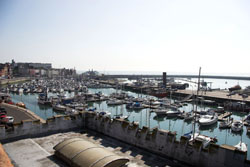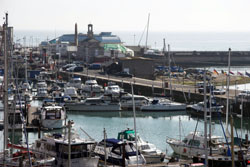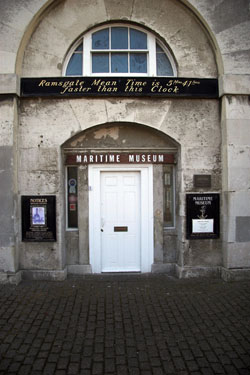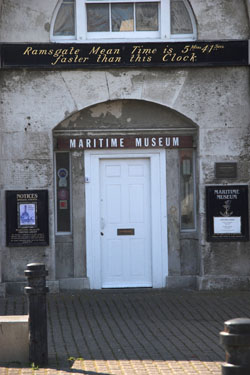Canon EF-S 17-85mm f/4-5.6 IS USM
Another addition to Canon’s slowly growing collection of EF-S lenses designed exclusively for the 300D, 350D 20D and now 30D cameras, this 17-85mm model is aimed at advanced amateur photographers as an extended standard zoom lens. We take a look at how it performs.
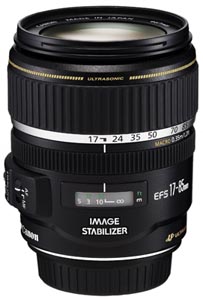 Specifications
Specifications
- Focal Length 17-85mm
- Max aperture f/4-5.6
- Construction 17/12 elements/groups
- Closest focus 0.35m
- Filter size 67mm
- Dimensions 78.5x92mm
- Weight 0.475kg
- Hood EW-73B (Optional, not supplied)
- Mount Canon EF-S only
- Price (SRP) £489.99
Build and handling
This lens, like most of the Canon stable, is nicely finished in a slightly off-gloss plastic and sports an all-metal mount. Forward of the mount is a distance window marked in metres and feet, and, as is the trend nowadays, no attempt has been made at including a depth-of-field scale. Alongside this, on the left of the barrel, is a raised panel with AF on/off and Image Stabilisation on/off switches. A narrow (10mm) manual focus ring is next along the barrel, with a broad zoom ring completing the controls. This is marked at the 17, 24, 35, 50, 70 and 85mm points and is torqued slightly loosely. The change in focal lengths extends the barrel on a double trombone by some 26mm although the front element does not rotate during the operation. This brings us up to the filter thread, a 67mm lip around the front element that is a little thin and delicate, witnessed by an existing crack in the optic supplied. Lugs for an EW-73B hood, which is an optional extra, are located around this lip. There was virtually no play in the trombone when extended.
The autofocus is Canon’s USM ultrasonic system, which is quick and virtually silent in operation and does tend to make the manual focus ring on this focal range almost redundant. The IS system has just a simple on/off switch and is Canon’s latest incarnation of the system which, they claim, is capable of three stops advantage in shutter speed. Taking the common ‘rule of thumb’ where shutter speed should be equal or greater than the focal length of the lens, with the lens set at 17mm, shutter speeds of more than 1/4sec should be possible hand held. I tried it and passable results were possible with more than 50% of the images. Quite impressive! The system cannot however, cope with panning at the same time.
Optical quality
This lens, claim the manufacturers, has the greatest zoom range in its class, and at a 5x ratio it is beyond the normally accepted range where compromises become a problem. Canon has managed those compromises fairly well, with one notable exception. That is in the department of distortion. At the wide-open end of 17mm distortion is quite noticeably barrelled and with a measured figure of –6.79% it is hardly surprising that it is evident to the eye. By the time you have gone through the zoom range to the 85mm end of the optic, the distortion has gone through the neutral point to reach an acceptable 0.9% pincushion. The good news is that distortion is one of the easiest problems to correct in editing software.
Having said that, the rest of the lens’s performance was good, especially in the resolution department where the figures held up very well over the focal range instead of dropping off badly at the longer end as most zooms do. For the most part, chromatic aberrations are well controlled except perhaps at the widest settings where some was evident towards the edges.
Contrast and colour reproduction, as is quite usual with Canon lenses, is well reproduced although the colour is a little more neutral than some other lenses in their range. The control of flare and ghosting is again good, with no incidences occurring even without the optional hood.
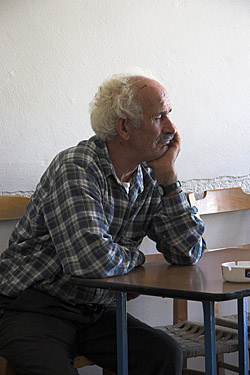 The lens’s focal range makes candid portraits easy with the 85mm long end. Canon 20D. 1/400sec at f/8. | 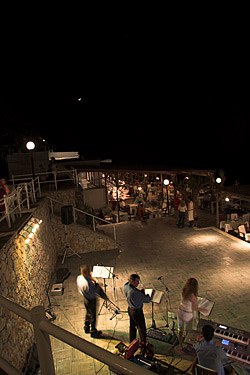 The two shots here were taken at 0.6 and 0.8sec respectively; both hand held and show just how good the Image stabilisation on this lens is. Canon 20D set at ISO400 and f/8. |
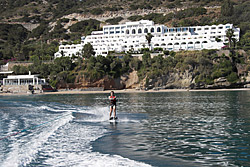 Many subjects do not show the distortion at the wide end as with this holiday shot taken at 17mm on a 20D. f/7.1 and 1/800sec. | 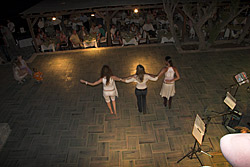 |
Click on each comparision photo below to view full size versions
Below is our lens test data. To find out how to use these graphs look at this article: How we test lenses
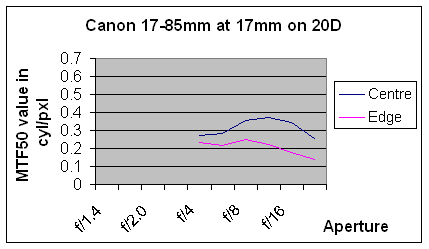
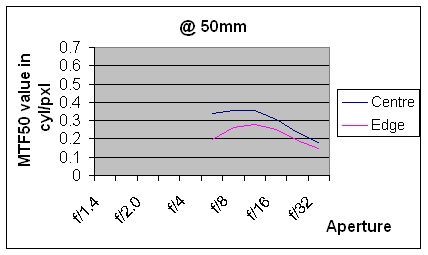
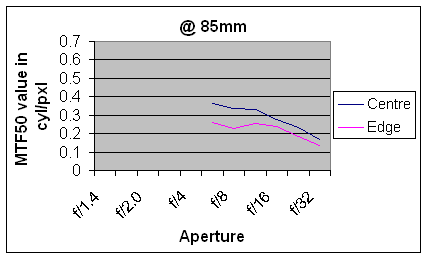
Verdict
I can’t help feeling that Canon have pushed the focal range a tad too far at the wide end of this optic because from the 20mm mark through to the 85mm end it is a cracking walkabout lens. It is only the widest few millimetres that let it down a touch. Having said that, with a little judicious work post processing images at that end, they are still very usable. The Image Stabilisation system is a boon in low lighting conditions and made pictures in those situations quite viable. For owners of the cameras that the lens will fit, it is a good addition to the camera bag.
In summary, the positive points of the Canon EF-S 17-85mm IS USM are:
![]() Excellent resolution holds up throughout the focal range.
Excellent resolution holds up throughout the focal range.
![]() IS system helps a lot in low light.
IS system helps a lot in low light.
![]() The lens makes a good replacement for kit lenses
The lens makes a good replacement for kit lenses
![]() The focal range ideal for a walkabout lens.
The focal range ideal for a walkabout lens.
The negative points are:
![]() Distortion is bad at the widest settings and a little CA creeps in.
Distortion is bad at the widest settings and a little CA creeps in.
![]() Front lip is prone to damage.
Front lip is prone to damage.
![]() Hood is an optional extra.
Hood is an optional extra.
Check the latest price for the Canon EF-S 17-85mm f/4-5.6 IS USM here
Discuss this lens and other related lens subjects here
Test by Ian Andrews www.wildaboutkent.com
Recommed that you buy the 17-40 F4L or 16-35 F2.8 both are built like a tank and save the hassel. I'm shopping around for another lens now!
Jim McMann
San Jose, CA. USA
I have found that it does suffer as you say, quite severe barrel distortion, which while relatively easy to correct in software does tend to diminish sharpness a little.
The lens also suffers from quite severe CA's or at least, my example does. Severe enough to be somewhat difficult to irradicate entirely through software.
I think Canon have tried to push the boat out too far with the zoom ratio of this lens and this has shown itself in several shortcomings.
Build quality is extremely questionable also with this lens. The zoom ring inertia is rediculously light to the point of being 'sloppy' I think - and quite annoying!
Again, comparing this lens to the EF-S 17-55mm f/2.8 IS USM lens which is after all, within the same range, bears absolutely no comparison. The 17-55mm f/2.8 is FAR superior in every respect with the exception of ultimate telephoto length. However, I would personally sooner forsake this and buy an additional 'better quality' lens which covers the longer focal length and beyond.
David Chamberlain
Add your message
Please login here or if you've not registered, you can register here. Registering is safe, quick and free.
photodo Stats
428 MTF tests
74 in-depth photodo reviews
100+ users join each day
Help the lens community by reviewing or rating a lens today via our lens search
Latest Lens Reviews
- Chinon 28mm f/2.8 Vintage Lens Review
- Canon EF 70-200mm f/4L IS II USM Lens Review
- Samyang AF 85mm f/1.4 EF Review
- Sigma 70mm f/2.8 DG Macro Art Review
- Samyang AF 24mm f/2.8 FE Review
- Meike 50mm f/1.7 Review
- Tamron 70-210mm f/4 Di VC USD Review
- Lensbaby Burnside 35mm f/2.8 Review
- Asahi Super Takumar 50mm f/1.4 Review
- Asahi Super-Multi-Coated Takumar 135mm f/3.5 Review
